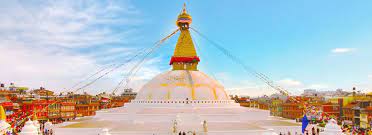Kathmandu Boudhanath Buddhist Stupa, Nepal

Address
Kathmandu Boudhanath Buddhist Stupa Boudhanath Sadak, Kathmandu 44600, Nepal Phone: +977 986-3319626
Deity
Buddha
Introduction
- Location: Situated about 11 km (6.8 miles) northeast of Kathmandu, Nepal.
- Significance:
- One of the largest spherical stupas in Nepal.
- A UNESCO World Heritage Site.
- Part of the ancient trade route from Tibet, connecting to the smaller Charumati Stupa (Little Boudhanath).
Puranic Significance
- Historical Background:
- Built shortly after the death of Lord Buddha in the 5th century AD during the reign of King Manadev (464-505 AD).
- Regarded as the world’s largest Chhyorten (stupa).
- Constructed using a significant amount of gold for decoration.
- Relics:
- Believed to house the remains of Kassapa Buddha.
- Legend of Construction:
- According to Newar Buddhist mythology, King Vikramaditya of the Licchavi kingdom ordered the construction of a dhunge dhara (stone water spout) in his palace courtyard.
- When the dhunge dhara produced no water, astrologers suggested a human sacrifice of a male with thirty-two perfections (Battis-Lakshanas).
- The king sacrificed himself; during the ceremony, his head flew to the nearby Sankhu Bajrayogini Temple.
- In his sorrow, a prince cast off a chicken from the temple, which landed at the site of the current Boudhanath Stupa.
- The name “Khāsti” comes from the local words for dew (“khas”) and drops (“ti”), referring to how people survived the drought by collecting dew.
Special Features
- Spiritual Environment:
- A deeply spiritual area where devotees circumambulate the stupa, chanting the mantra “Om Mani Padme Hum” multiple times daily.
- During full moon days, monks engage in prayers and songs, attracting many Buddhists to visit.
- Architectural Elements:
- Represents the five elements associated with Buddha: earth, air, water, fire, and space.
- It is believed that many Buddhas have incarnated as Lamas at Boudhanath, and the rays of Bodhisattva enter the stupa in the form of heavenly songs.
- Cultural Reverence:
- Viewed with great reverence alongside other important sites like Sange, Thange, Duibe, and Chorten.
- Access and Surroundings:
- Main entrance located on the north side of the upper platform.
- The area surrounding the stupa features narrow streets and alleys adorned with Buddha images and vibrant scripts.
Century/Period/Age
5th century AD
Managed By
UNESCO World Heritage Centre.
Nearest Bus Station
Kathmandu
Nearest Railway Station
Raxaul junction
Nearest Airport
Tribhuvan International Airport









